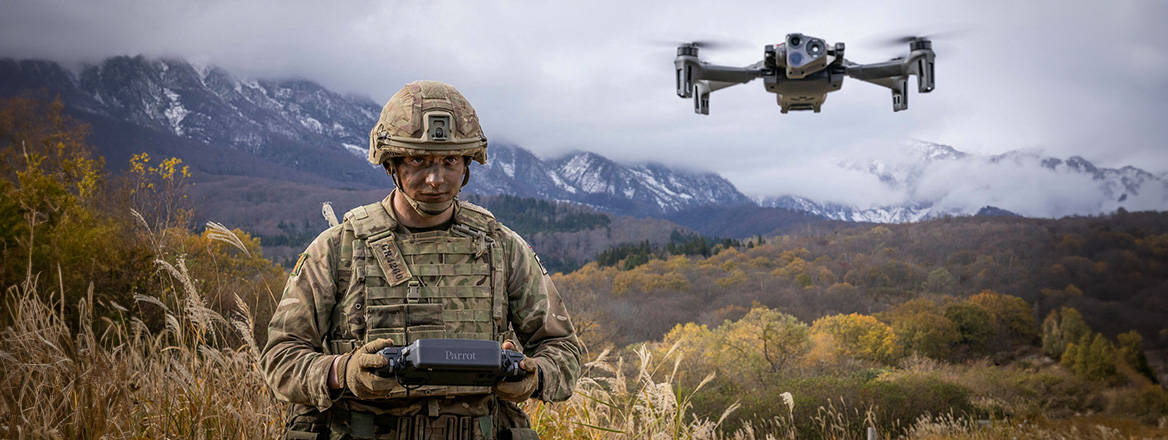RUSI
|
|
Can Technology Solve the UK Military’s Problems?
Instead of relying on technology to mitigate the shortfalls in the UK military, leaders must reduce their military commitments and be increasingly disciplined in their priorities.

The past several months have seen numerous publications diagnosing the problems facing the UK military: underfunding, vehicles and equipment shortages, morale and recruitment crises, and an inefficient – even ‘broken’ – procurement system. Meanwhile, the ‘say/do gap’ continues to grow; experts do not believe that the military could deploy and sustain more than a brigade in the event of a conflict, while the government is still committed to deploying a division for NATO. In response to this ‘hollow force’, policymakers and commanders frequently turn to technology, especially digital technology, as the solution.
The Promise of Technology
Advances in AI, autonomy and data processes will theoretically make a leaner military that is faster, smarter and more lethal. This fully integrated and interoperable force could offset personnel deficits by using AI for intelligence aggregation and analysis, alongside autonomous platforms that increase ISR capabilities and lethality without human intervention. A military capable of instantaneous data sharing across systems and platforms would permit decision advantage in speed and informational overmatch. Essentially, policymakers and practitioners are betting on a military that forgoes massed warfighting in favour of smaller-scale, digitally-enabled physical and information manoeuvre.
The Reality
Unfortunately, the Ministry of Defence (MoD) faces too many constraints to bring this vision to life. Despite the maturity of disruptive technologies, scaling them to operational capability remains a significant challenge.
The UK’s military roles, from its nuclear deterrent in Trident to securing international trade routes and deploying on peacekeeping and humanitarian missions, are too broad for its current resources
Many of these problems are simply indicative of broader trends within the MoD. Despite massive spending, money is not sufficiently well managed to develop, procure, integrate and upgrade key technologies. The MoD’s procurement difficulties are also well known and the target of reforms, but progress will not occur at the pace needed for large-scale deployment and rapid updating of mature digital and software-defined capabilities in the coming years. Finally, using technology to offset mass remains a contentious topic, with the war in Ukraine fuelling calls for both more conventional and intelligent mass in military planning.
Yet software-enabled systems face their own novel hurdles. The MoD and services are crippled by data silos, where data sources and stores are too localised to allow proper data transfer and exploitation. Discrepancies in classification levels exacerbate these silos and prevent data sharing. Many of these systems are legacy, requiring a choice between replacement, upgrade or integration with new systems. Even if systems can be integrated (a branch of Defence Digital found that a fifth of its data cannot be automated because the systems were simply too old), the process of integration is prohibitively complex, expensive and time-consuming. This type of systems design has seen limited success at great cost, with the Morpheus ‘Evolve to Open’ project providing the quintessential example.
Complicating every aspect of these issues is the dramatic digital skills shortage in the MoD (although this is not exclusive to the department). Defence cannot be intelligentised if it lacks both the technical experts and generalists with digital competency, as not only can the necessary systems not be developed or procured proficiently, but the technology also cannot be exploited to benefit the enterprise or operators.
While the MoD has outlined numerous strategies to incorporate SMEs, the cutting-edge of modern technological innovation remains largely disenfranchised from military procurement. Beyond procurement processes, the MoD’s relationships with industry and its very organisational structure are aligned to develop technology with and procure from the primes. SMEs with products and services badly needed by the MoD (such as automated software accreditation, digital twins or integrated classified data sharing) struggle to get noticed by defence officials at all, let alone survive long enough to get money from a contract. The barriers to entry restrict the number of tech companies that join the defence ecosystem, unless they manage to be subcontracted or acquired by a prime.
None of these limitations will be news to defence leaders and policymakers, yet they continue to rely on a vision that cannot be brought to fruition.
The Solutions
Instead of thinking of technology as a panacea, the most effective – and potentially the only, unless the government has many tens of billions of pounds to spare – solution for the military to match its commitments is to scale them down. The UK’s military roles, from its nuclear deterrent in Trident to securing international trade routes and deploying on peacekeeping and humanitarian missions, are too broad for its current resources.
Policymakers must recognise that the UK is a medium power, at least in military matters, despite its massive spending. To maintain some semblance of military proficiency, it must reduce its military commitments to prioritise its own territorial, then regional, security. The military internationalism that is such a source of UK pride is no longer a reality, so it must narrow its scope to NATO, eschewing the lure of distant expeditions and their meagre successes.
UK military strength cannot lie in chasing every technological advancement, but should instead be based on making deliberate, strategic choices to ensure sustainable and reliable capabilities
Throwing billions more into the defence budget will not change these deficiencies. A bloated and inefficient MoD is nothing new, yet the military finds itself paying ever more for less. The MoD’s fiscal incontinence prevents further influxes of cash from improving capability absent fundamental changes to the department’s operation. Concerns about capability should be addressed through overhauling the defence establishment’s organisation and processes, not by arguing for greater spending. Such arguments align with the budgetary pressures which frame the new government’s platform. Providing billions to a ministry infamous for inefficiency and waste will prove controversial given the perceived state of wider UK infrastructure and the NHS.
More Tough Choices
The UK cannot bet on technological overmatch for all capabilities against a peer threat. Rather, leaders will need to make a series of difficult choices on their priorities, beginning with the overall strategic posture outlined in the current defence review. The new government has indicated that cuts to defence are imminent, but these must be matched by a similar diminution in military ambitions. Limiting the scope of military commitments would permit future MoD programmes to be increasingly selective in their technological wagers, reducing the strain on the MoD and its integration efforts. Such an approach would allow greater resources to be committed to a smaller set of critical digital enablers and capabilities, thereby enhancing overall effectiveness instead of stretching resources thin across an unsustainable array of commitments. The UK’s approach must be measured and realistic, and focused entirely on the core priorities that align with its capabilities as a medium power.
For example, the ongoing overhaul of the MoD’s IT infrastructure is necessary for ensuring its basic functionality in today’s digital era, yet policymakers should think critically about how far to take this transformation. The successful implementation of such initiatives hinges on strict priorities, disciplined resource allocation, and a willingness to make difficult trade-offs in the pursuit of sustainable and strategic advantages.
The ambitions of an enterprise defined by advanced decision support systems, ‘seamless integration’, ‘information overmatch’ and open architectures may one day be the future of the UK military. However, UK military strength cannot lie in chasing every technological advancement, but should instead be based on making deliberate, strategic choices to ensure sustainable and reliable capabilities.
The author used generative AI as a writing aid during the creation of this Commentary.
The views expressed in this Commentary are the author’s, and do not represent those of RUSI or any other institution.
Have an idea for a Commentary you’d like to write for us? Send a short pitch to commentaries@rusi.org and we’ll get back to you if it fits into our research interests. Full guidelines for contributors can be found here.
Original article link: https://rusi.org/explore-our-research/publications/commentary/can-technology-solve-uk-militarys-problems


